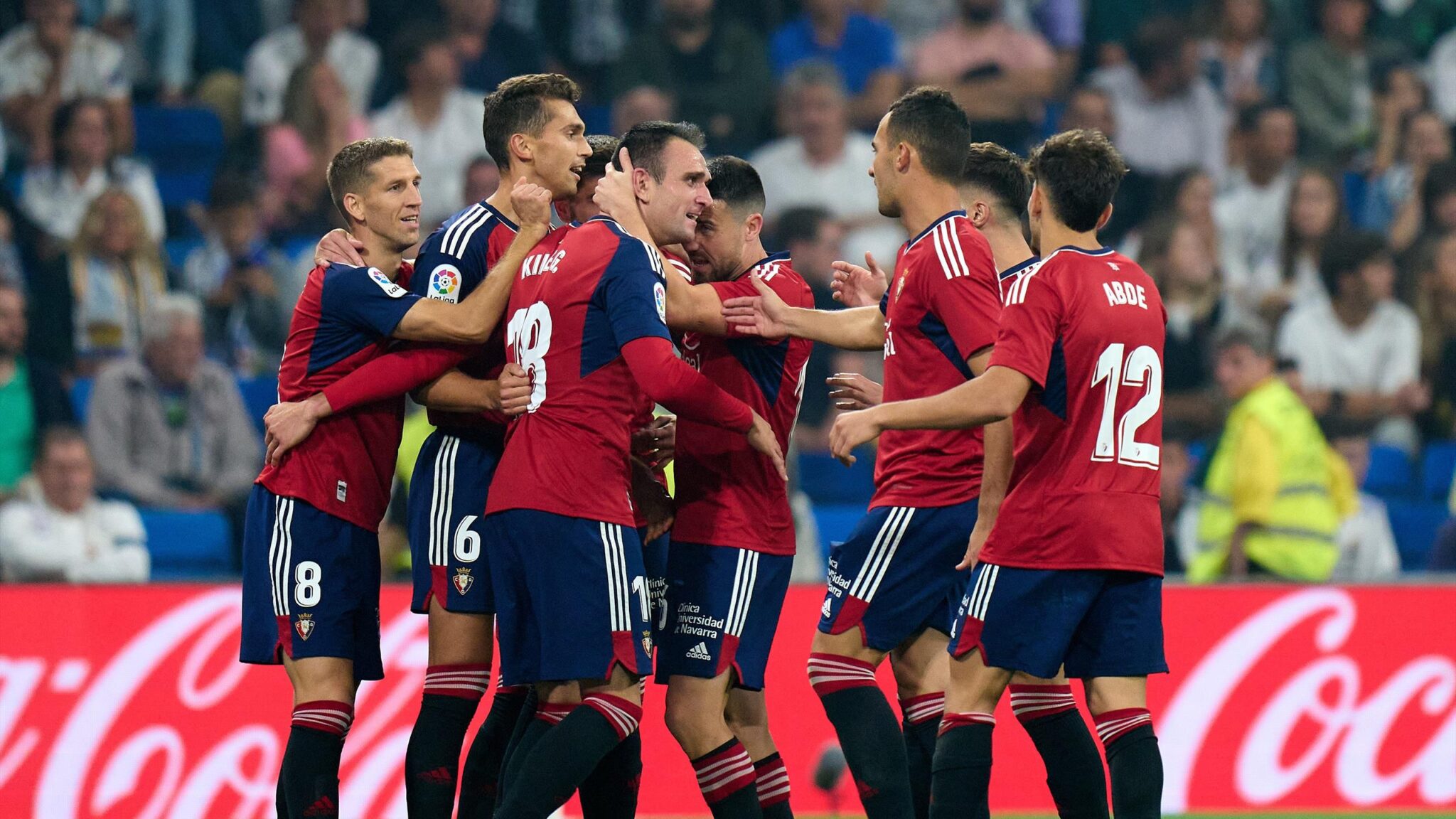© The Fan Experience Company 2022

Osasuna: Where future stars are formed from fans on their doorstep
There’s a job waiting at the Navarra tourist board when Jon Moncayola hangs up his boots. Straight off the bat he’ll give you two great reasons to visit Pamplona – the famous San Fermin festival, and the less renowned Osasuna.
Moncayola has been a regular at El Sadar Stadium since he was three years old. He started going with his family as a fan, which most residents in Navarra are, given Osasuna are the only professional club in a region of around 650,000 people.
But the 24-year-old is one of the few to have lived out their dream. He joined the academy aged 10 and last year signed a decade-long contract that will keep him at his boyhood team until 2031.
The midfielder will also tell you how Navarros possess a “fighting spirit, of never giving in, we’re very headstrong” and Osasuna supporters have a legitimate claim to being the most passionate in the division.
They are certainly the loudest, recording a Spanish-record 115.17-decibel roar inside a raucous El Sadar as they beat Real Madrid on the final day of the 2008-09 season to avoid relegation.
More recently, as one of four member-owned clubs in La Liga, the socios voted to renovate a ground that claims to be the league’s highest-attended venue by percentage of its 23,516 capacity.
“It’s something unique, inexplicable,” says Moncayola. “For the few people we can get in, they make it sound like somewhere much bigger, because what you hear is incredible and the atmosphere unique.”
In Moncayola’s lifetime, he has seen Osasuna almost reach the Champions League but also narrowly avoid relegation to the third tier amid spiralling club debt.
This is their fourth successive season in La Liga, and a club built largely on academy graduates is on the rise – Los Rojillos sit eighth, one point off a European spot, having already beaten Sevilla and drawn at Real Madrid.
“We’re playing every weekend with lads we’ve spent many years with in the youth teams,” adds Moncayola, one of 10 players from Osasuna’s Tajonar ‘cantera’ currently in the first-team squad.
“Even these days some of us don’t believe it, you step out onto pitch of the Bernabeu or Camp Nou, and you look at each other and go ‘we’re here!’. Playing against players like Vinicius Jr or (Karim) Benzema. It’s incredible.”
The midfielder will also tell you how Navarros possess a “fighting spirit, of never giving in, we’re very headstrong” and Osasuna supporters have a legitimate claim to being the most passionate in the division.
They are certainly the loudest, recording a Spanish-record 115.17-decibel roar inside a raucous El Sadar as they beat Real Madrid on the final day of the 2008-09 season to avoid relegation.
More recently, as one of four member-owned clubs in La Liga, the socios voted to renovate a ground that claims to be the league’s highest-attended venue by percentage of its 23,516 capacity.
“It’s something unique, inexplicable,” says Moncayola. “For the few people we can get in, they make it sound like somewhere much bigger, because what you hear is incredible and the atmosphere unique.”
In Moncayola’s lifetime, he has seen Osasuna almost reach the Champions League but also narrowly avoid relegation to the third tier amid spiralling club debt.
This is their fourth successive season in La Liga, and a club built largely on academy graduates is on the rise – Los Rojillos sit eighth, one point off a European spot, having already beaten Sevilla and drawn at Real Madrid.
“We’re playing every weekend with lads we’ve spent many years with in the youth teams,” adds Moncayola, one of 10 players from Osasuna’s Tajonar ‘cantera’ currently in the first-team squad.
“Even these days some of us don’t believe it, you step out onto pitch of the Bernabeu or Camp Nou, and you look at each other and go ‘we’re here!’. Playing against players like Vinicius Jr or (Karim) Benzema. It’s incredible.”
The man tasked with delivering stars of tomorrow is club legend Patxi Punal, another Navarro who began following the side “as a toddler when I didn’t even have teeth yet” but went on to play 513 times in a Los Rojillos jersey.
Punal, having returned as academy director, sees the low point of 2014-15 as the platform for which Osasuna’s success is now built, earning promotion to the top flight in 2017 and restoring that place two years later.
“Osasuna has always been a club that homegrown players have been an important part of the squad,” he says. “In that moment, in those economic times, the club committed to that.
“That initiated a stability from which everything has followed. It started a new process, where the club cleansed itself, it started to pick up air with that promotion, it started to structure again around the academy.
“A few people came together and worked relentlessly to structure again the club and the formation of these young lads, to guarantee them a quality football education.”
Punal is passionate about developing youngsters both as players and people, and feels a responsibility to the region to do so.
A clearly defined education strategy that includes academic, human and psychological aspects stands the many who do not make it professional in good stead for life elsewhere.
“We’re lucky,” says Punal. “Our people, our fans, our idea of football, our philosophy is something all centred on a homegrown team. Our people, our fans, I don’t know if they’d so identify with a team that, as well as it played, didn’t have an important number of homegrown players.
“That makes us work with more care, more emotion, more dedication, and you put everything into the academy, trying to improve the work processes, trying to have something that makes the difference for the lads – we owe it to them to do it like that.”
Osasuna face competition from Basque neighbours Real Sociedad and Athletic Bilbao, as well as Barcelona and Real Madrid, so have to be “very clever” with recruitment, and Punal delights in providing hidden talents an environment where they can “express themselves” and realise their potential.
“In our schools, you have to be able to detect players,” he says. “In the end, to be a professional, you first have to have talent. Then a good education.
“It’s true us Navarros have special characteristics. A lot of character. We never give in, we persevere, very supportive. I think we’re trustworthy players. I think you know what you’re getting from us in any given moment.
“We don’t distinguish by quality. We have it defined, that you can always identify an Osasuna player, an Osasuna team.”
Punal also believes Osasuna offer the best path for players from the region into first-team football.
“The formative model is concepts and things that help our kids to play football anywhere in the world, in Pamplona, Villarreal, Barcelona, if they go to Athletic, wherever, the concepts of play, control, passing,” he says.
“The model of play, which is the characteristics of Osasuna – to press high, to chase lost balls, attacking from the front. Then we have complementary models, so we look for more competitive games for our kids.
“Then there’s work on lines, on positions. We sometimes have them work with the first-team players. We present to them how we want to work with them, defensive drills, drills that the first team do, then they go and practice them simultaneously.
“It is marvellous, to have the support of these players of the first team. A manager they see every day can say one thing, but when a Chimy Avila comes down, oof… that’s something that’s not that normal, either in Spain or outside. It’s something we do, a connection between the first team and the academy.”
It also means on Sunday, when Osasuna host Real Valladolid, there will likely be another young Navarro roaring in the crowd, ready to replicate heroes Moncayola and Punal at El Sadar when their time comes.
Original article published 25.10.2022 on the BBC Sport website.
To view the full article, click here
